Monitoring the Setting Process of Cementitious Materials Using Guided Waves in Thin Rods
Abstract
1. Introduction
2. Materials and Methods
2.1. Materials
2.2. Ultrasonic Test Setup
2.3. Penetrometer Tests
3. Results and Discussions
3.1. Shear Wave Velocity Testing
3.2. Guided Wave Testing
4. Conclusions
Author Contributions
Funding
Institutional Review Board Statement
Informed Consent Statement
Data Availability Statement
Conflicts of Interest
References
- Javier Vazquez-Rodriguez, F.; Elizondo-Villareal, N.; Hypatia Verastegui, L.; Arato Tovar, A.M.; Fernando Lopez-Perales, J.; de Leon, J.E.; Gomez-Rodriguez, C.; Fernandez-Gonzalez, D.; Felipe Verdeja, L.; Viviana Garcia-Quinonez, L.; et al. Effect of Mineral Aggregates and Chemical Admixtures as Internal Curing Agents on the Mechanical Properties and Durability of High-Performance Concrete. Materials 2020, 13, 2090. [Google Scholar] [CrossRef] [PubMed]
- Kim, S.S.; Qudoos, A.; Jakhrani, S.H.; Lee, J.B.; Kim, H.G. Influence of Coarse Aggregates and Silica Fume on the Mechanical Properties, Durability, and Microstructure of Concrete. Materials 2019, 12, 3324. [Google Scholar] [CrossRef] [PubMed]
- Long, W.-J.; Khayat, K.H.; Lemieux, G.; Hwang, S.-D.; Han, N.-X. Performance-Based Specifications of Workability Characteristics of Prestressed, Precast Self-Consolidating Concrete-A North American Prospective. Materials 2014, 7, 2474–2489. [Google Scholar] [CrossRef] [PubMed]
- ASTM C403/C403M-08. Standard Test Method for Time of Setting of Concrete Mixtures by Penetration Resistance; ASTM International, 100 Barr Harbor Drive: West Conshohocken, PA, USA, 2008. [Google Scholar] [CrossRef]
- Liu, S.; Zhu, J.; Seraj, S.; Cano, R.; Juenger, M. Monitoring setting and hardening process of mortar and concrete using ultrasonic shear waves. Constr. Build. Mater. 2014, 72, 248–255. [Google Scholar] [CrossRef]
- Boumiz, A.; Vernet, C.; Tenoudji, F.C. Mechanical properties of cement pastes and mortars at early ages: Evolution with time and degree of hydration. Adv. Cem. Based Mater. 1996, 3, 94–106. [Google Scholar] [CrossRef]
- Chotard, T.; Gimet-Breart, N.; Smith, A.; Fargeot, D.; Bonnet, J.P.; Gault, C. Application of ultrasonic testing to describe the hydration of calcium aluminate cement at the early age. Cem. Concr. Res. 2001, 31, 405–412. [Google Scholar] [CrossRef]
- D’Angelo, R.; Plona, T.J.; Schwartz, L.M.; Coveney, P. Ultrasonic measurements on hydrating cement slurries: Onset of shear wave propagation. Adv. Cem. Based Mater. 1995, 2, 8–14. [Google Scholar] [CrossRef]
- Keating, J.; Hannant, D.J.; Hibbert, A.P. Comparison of shear modulus and pulse velocity techniques to measure the build-up of structure in fresh cement pastes used in oil well cementing. Cem. Concr. Res. 1989, 19, 554–566. [Google Scholar] [CrossRef]
- Sant, G.; Ferraris, C.F.; Weiss, J. Rheological properties of cement pastes: A discussion of structure formation and mechanical property development. Cem. Concr. Res. 2008, 38, 1286–1296. [Google Scholar] [CrossRef]
- Sayers, C.M.; Dahlin, A. Propagation of ultrasound through hydrating cement pastes at early times. Adv. Cem. Based Mater. 1993, 1, 12–21. [Google Scholar] [CrossRef]
- Ye, G.; van Breugel, K.; Fraaij, A.L.A. Experimental study and numerical simulation on the formation of microstructure in cementitious materials at early age. Cem. Concr. Res. 2003, 33, 233–239. [Google Scholar] [CrossRef]
- Reinhardt, H.W.; Grosse, C.U. Continuous monitoring of setting and hardening of mortar and concrete. Constr. Build. Mater. 2004, 18, 145–154. [Google Scholar] [CrossRef]
- Sayers, C.M.; Grenfell, R.L. Ultrasonic propagation through hydrating cements. Ultrasonics 1993, 31, 147–153. [Google Scholar] [CrossRef]
- Lee, H.K.; Lee, K.M.; Kim, Y.H.; Yim, H.; Bae, D.B. Ultrasonic in-situ monitoring of setting process of high-performance concrete. Cem. Concr. Res. 2004, 34, 631–640. [Google Scholar] [CrossRef]
- Qin, L.; Li, Z. Monitoring of cement hydration using embedded piezoelectric transducers. Smart Mater. Struct. 2008, 17, 55005. [Google Scholar] [CrossRef]
- Rapoport, J.R.; Popovics, J.S.; Kolluru, S.V.; Shah, S.P. Using ultrasound to monitor stiffening process of concrete with admixtures. ACI Mater. J. 2000, 97, 675–683. [Google Scholar]
- Voigt, T.; Grosse, C.U.; Sun, Z.; Shah, S.P.; Reinhardt, H.W. Comparison of ultrasonic wave transmission and reflection measurements with P-and S-waves on early age mortar and concrete. Mater. Struct. 2005, 38, 729–738. [Google Scholar] [CrossRef]
- Dumoulin, C.; Karaiskos, G.; Carette, J.; Staquet, S.; Deraemaeker, A. Monitoring of the ultrasonic P-wave velocity in early-age concrete with embedded piezoelectric transducers. SMART Mater. Struct. 2012, 21, 047001. [Google Scholar] [CrossRef]
- Zhu, J.; Cao, J.N.; Bate, B.; Khayat, K.H. Cement and Concrete Research Determination of mortar setting times using shear wave velocity evolution curves measured by the bender element technique. Cem. Concr. Res. 2018, 106, 1–11. [Google Scholar] [CrossRef]
- Zhu, J.; Kee, S.-H.; Han, D.; Tsai, Y.-T. Effects of air voids on ultrasonic wave propagation in early age cement pastes. Cem. Concr. Res. 2011, 41, 872–881. [Google Scholar] [CrossRef]
- Zhu, J.; Tsai, Y.-T.; Kee, S.-H. Monitoring early age property of cement and concrete using piezoceramic bender elements. Smart Mater. Struct. 2011, 20, 115014. [Google Scholar] [CrossRef]
- Carette, J.; Staquet, S. Monitoring the setting process of mortars by ultrasonic P and S-wave transmission velocity measurement. Constr. Build. Mater. 2015, 94, 196–208. [Google Scholar] [CrossRef]
- Li, F.; Murayama, H.; Kageyama, K.; Shirai, T. Guided Wave and Damage Detection in Composite Laminates Using Different Fiber Optic Sensors. Sensors 2009, 9, 4005–4021. [Google Scholar] [CrossRef] [PubMed]
- Ghavamian, A.; Mustapha, F.; Baharudin, B.T.H.T.; Yidris, N. Detection, Localisation and Assessment of Defects in Pipes Using Guided Wave Techniques: A Review. Sensors 2018, 18, 4470. [Google Scholar] [CrossRef]
- Radzienski, M.; Kudela, P.; Marzani, A.; De Marchi, L.; Ostachowicz, W. Damage Identification in Various Types of Composite Plates Using Guided Waves Excited by a Piezoelectric Transducer and Measured by a Laser Vibrometer. Sensors 2019, 19, 1958. [Google Scholar] [CrossRef]
- Zima, B.; Kedra, R. Numerical Study of Concrete Mesostructure Effect on Lamb Wave Propagation. Materials 2020, 13, 2570. [Google Scholar] [CrossRef]
- Lee, C.; Park, S.; Bolander, J.E.; Pyo, S. Monitoring the hardening process of ultra high performance concrete using decomposed modes of guided waves. Constr. Build. Mater. 2018, 163, 267–276. [Google Scholar] [CrossRef]
- Vogt, T.; Lowe, M.; Cawley, P.; Introduction, I. The scattering of guided waves in partly embedded cylindrical structures. J. Acoust. Soc. Am. 2013, 113, 1258–1272. [Google Scholar] [CrossRef]
- Sharma, S.; Mukherjee, A. Cement & Concrete Composites Monitoring freshly poured concrete using ultrasonic waves guided through reinforcing bars. Cem. Concr. Compos. 2015, 55, 337–347. [Google Scholar] [CrossRef]
- Sharma, S.; Mukherjee, A. Ultrasonic guided waves for monitoring the setting process of concretes with varying workabilities. Constr. Build. Mater. 2014, 72, 358–366. [Google Scholar] [CrossRef]
- Ervin, B.L.; Kuchma, D.A.; Bernhard, J.T.; Reis, H. Monitoring Corrosion of Rebar Embedded in Mortar Using High-Frequency Guided Ultrasonic Waves. J. Eng. Mech. 2009, 135, 9–19. [Google Scholar] [CrossRef]
- Vogt, T.; Lowe, M.; Cawley, P. Cure monitoring using ultrasonic guided waves in wires. J. Acoust. Soc. Am. 2004, 114, 1303–1313. [Google Scholar] [CrossRef] [PubMed]
- Sun, H.; Zhu, J. Monitoring Early Age Properties of Cementitious Material Using Ultrasonic Guided Waves in Embedded Rebar. J. Nondestruct. Eval. 2017, 36, 1–12. [Google Scholar] [CrossRef]
- Seco, F.; Jiménez, A.R.; Automática, C. De Modelling the Generation and Propagation of Ultrasonic Signals in Cylindrical Waveguides. In Ultrasonic Waves; dos Santos, A.A., Jr., Ed.; IntechOpen: London, UK; Available online: https://www.intechopen.com/books/ultrasonic-waves/modelling-the-generation-and-propagation-of-ultrasonic-signals-in-cylindrical-waveguides (accessed on 18 January 2021). [CrossRef]
- Pu, S.H.; Cegla, F.; Drozdz, M.; Lowe, M.J.S.; Cawley, P.; Buenfeld, N.R. Monitoring the setting and early hardening of concrete using an ultrasonic waveguide. Insight 2004, 46, 350–354. [Google Scholar] [CrossRef]

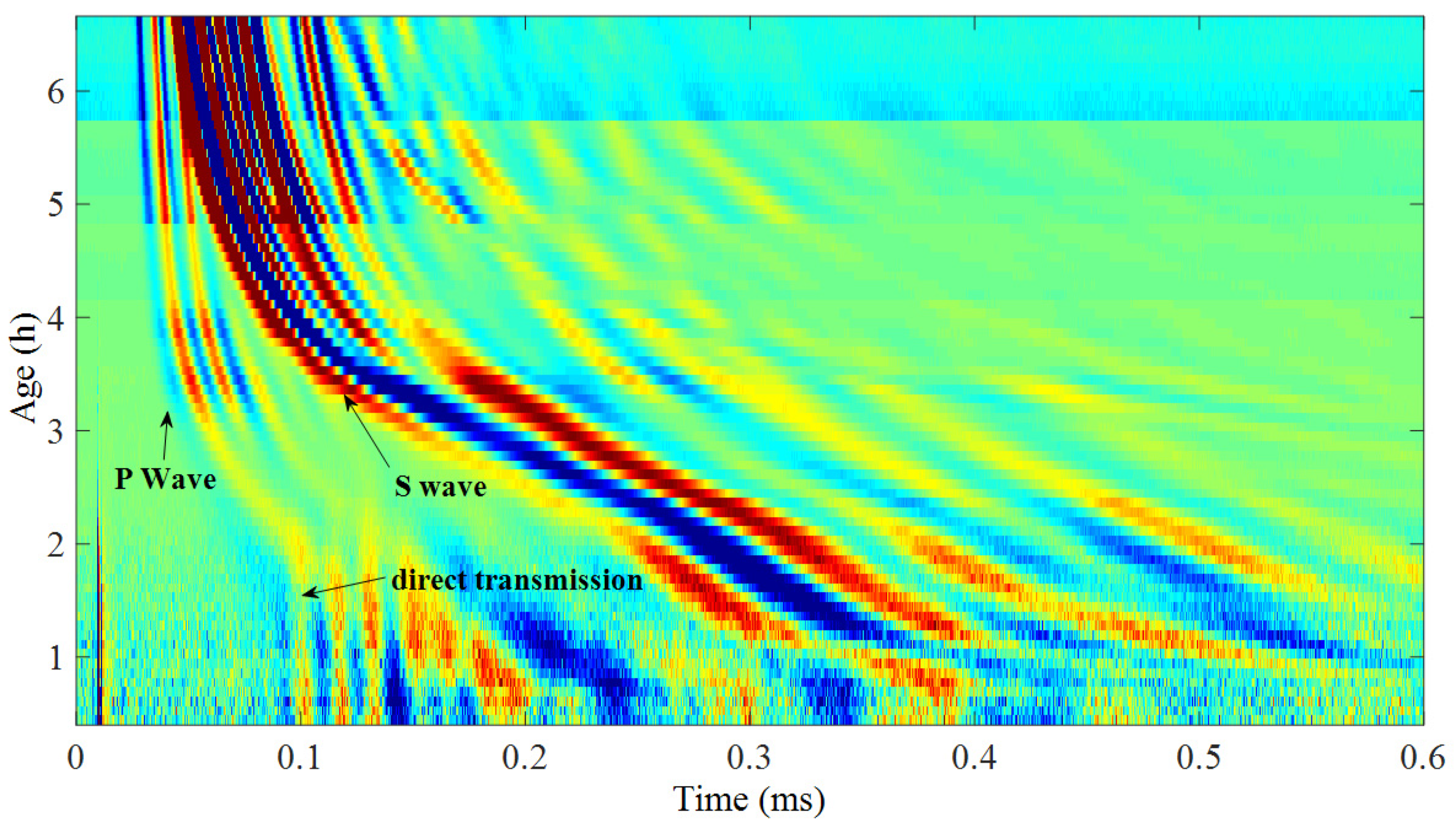
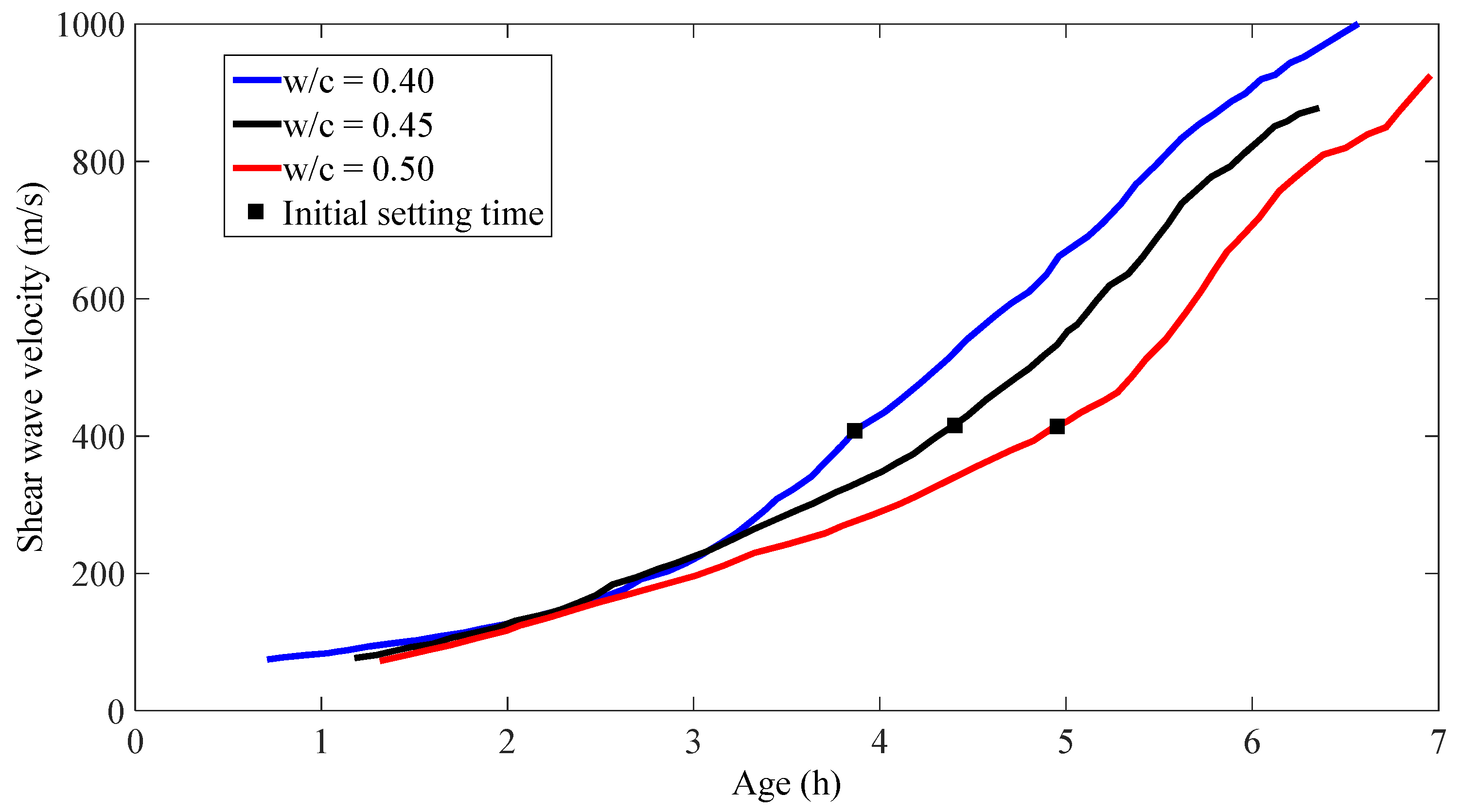

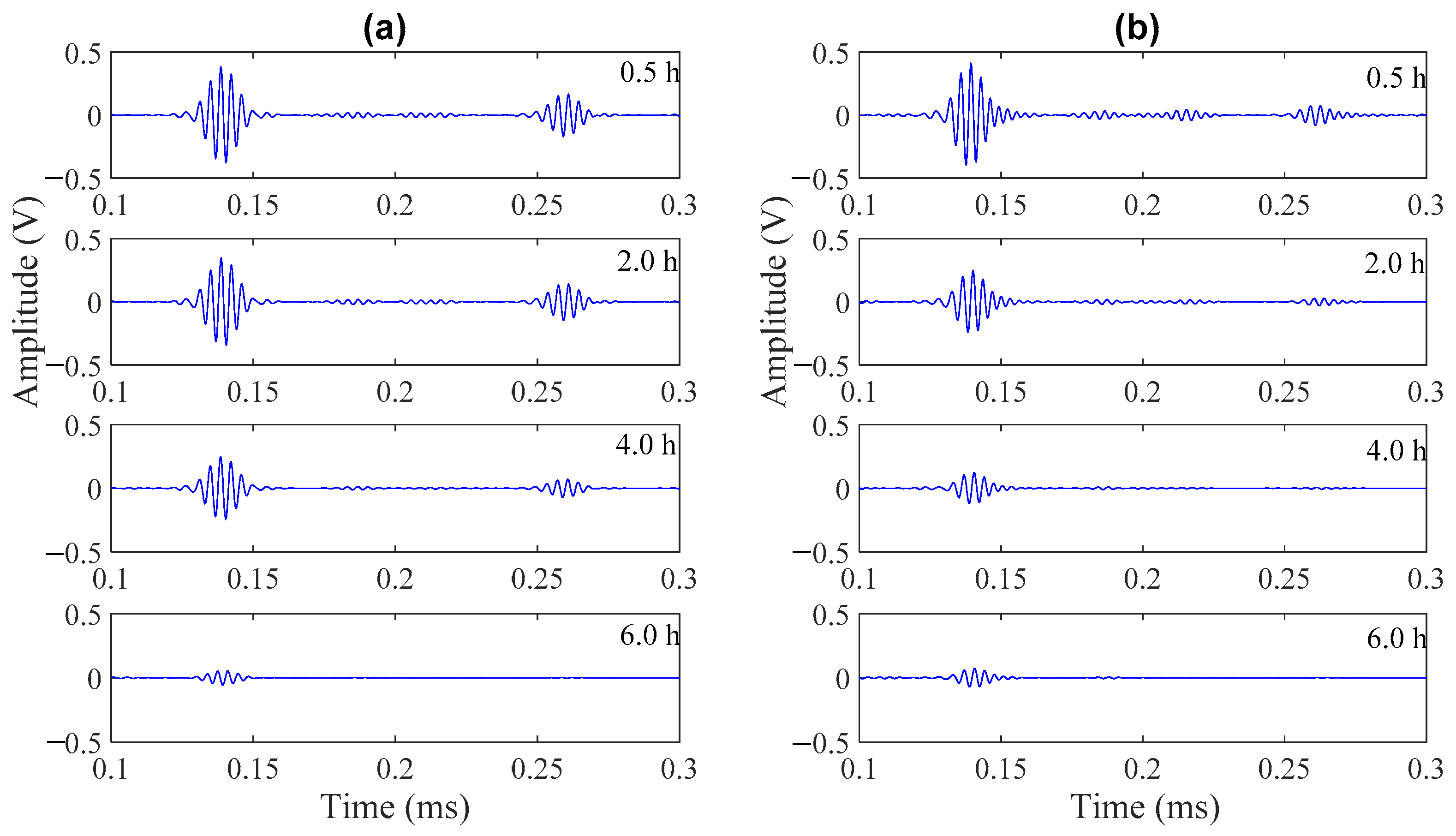

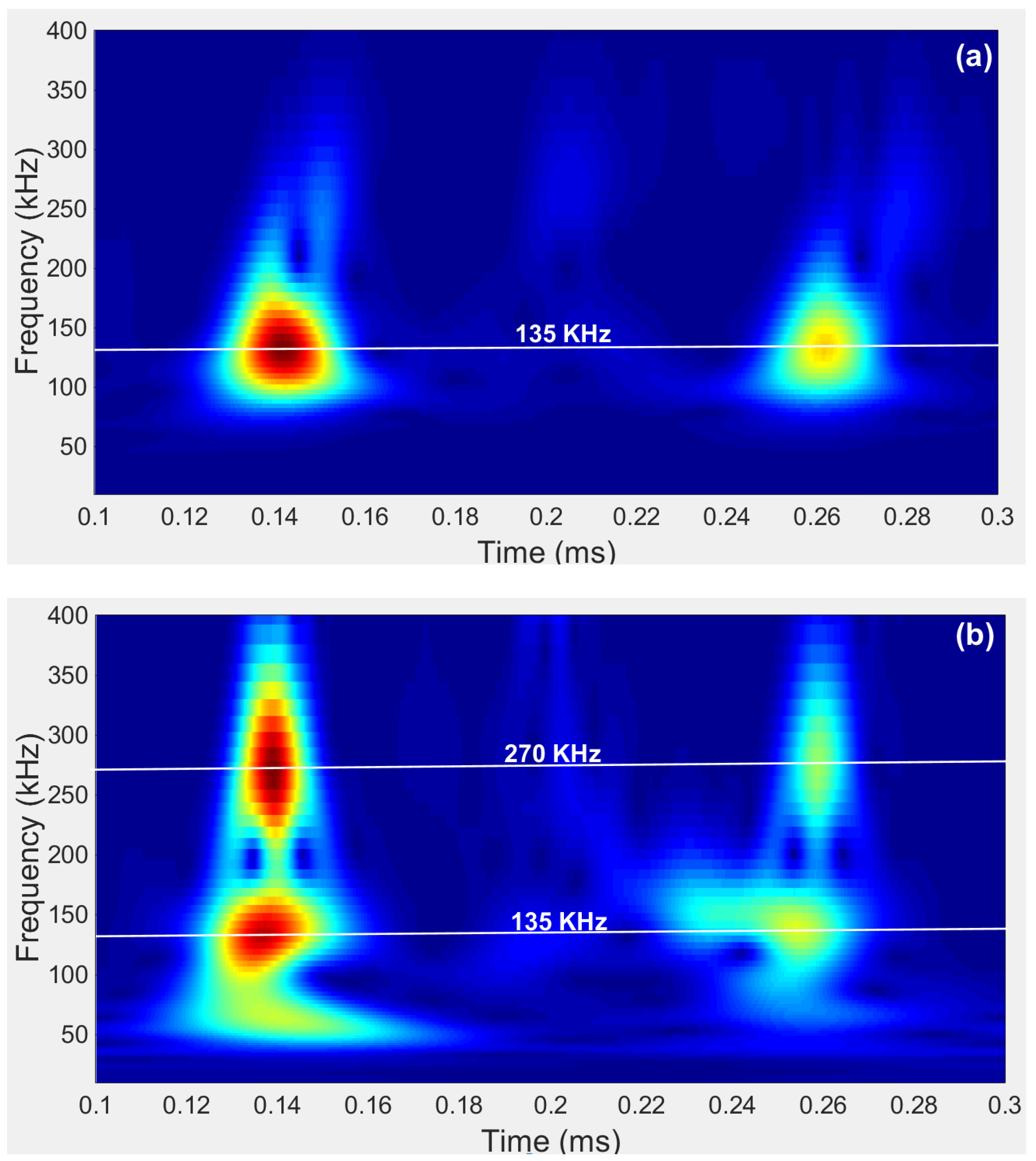
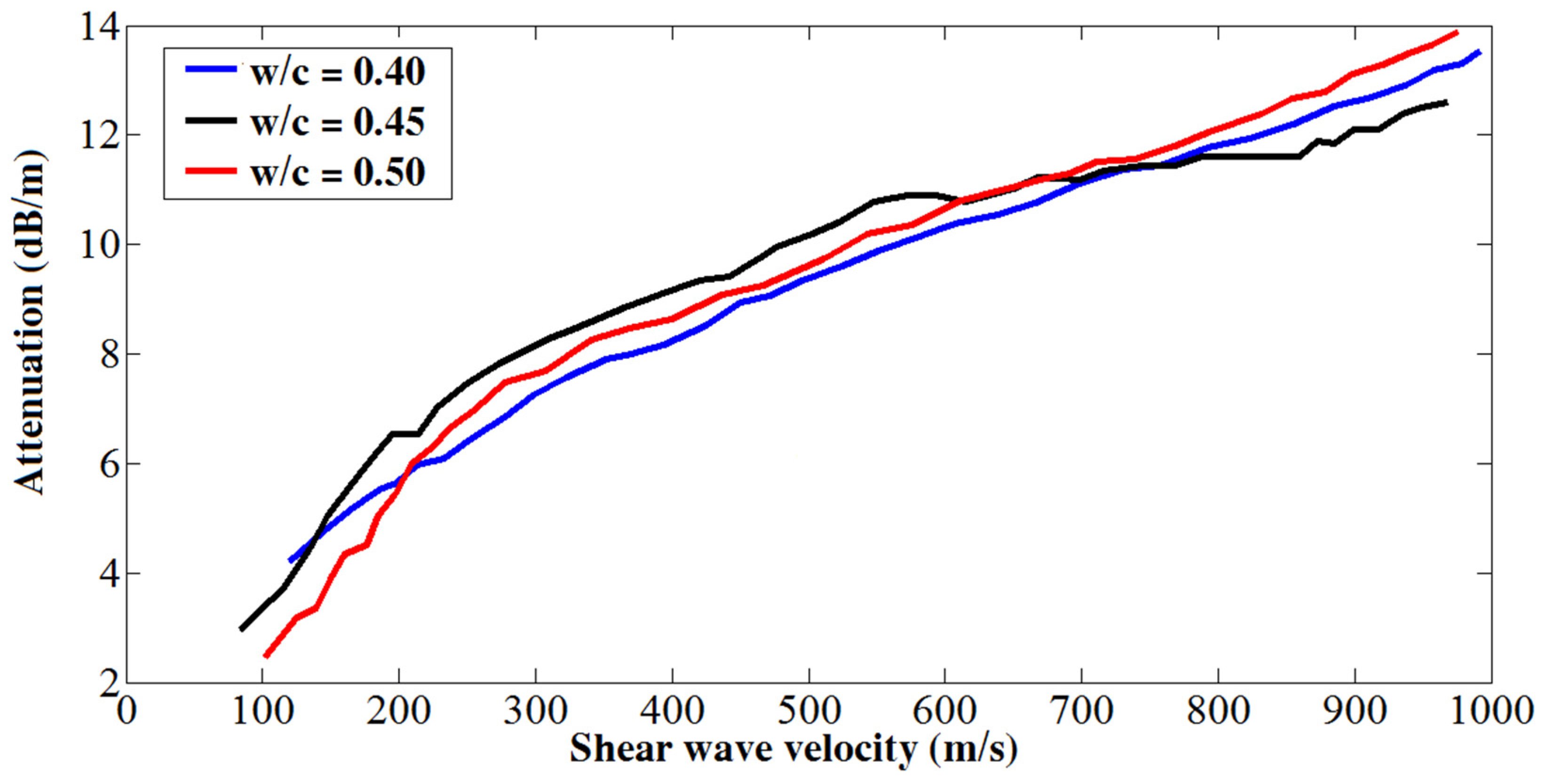


| w/c | Sample Type | Coarse Aggregate Volume (%) | Fine Aggregate Volume (%) | Initial Setting Time (min) | Final Setting Time (min) |
|---|---|---|---|---|---|
| 0.40 | mortar | – | 51.1 | 232 | 342 |
| 0.45 | mortar | – | 51.1 | 264 | 371 |
| 0.50 | mortar | – | 51.1 | 297 | 399 |
| 0.50 | concrete | 43.4 | 28.9 | 281 | 384 |
Publisher’s Note: MDPI stays neutral with regard to jurisdictional claims in published maps and institutional affiliations. |
© 2021 by the authors. Licensee MDPI, Basel, Switzerland. This article is an open access article distributed under the terms and conditions of the Creative Commons Attribution (CC BY) license (http://creativecommons.org/licenses/by/4.0/).
Share and Cite
Wang, D.; Yu, G.; Liu, S.; Sheng, P. Monitoring the Setting Process of Cementitious Materials Using Guided Waves in Thin Rods. Materials 2021, 14, 566. https://doi.org/10.3390/ma14030566
Wang D, Yu G, Liu S, Sheng P. Monitoring the Setting Process of Cementitious Materials Using Guided Waves in Thin Rods. Materials. 2021; 14(3):566. https://doi.org/10.3390/ma14030566
Chicago/Turabian StyleWang, Dongquan, Guangyun Yu, Shukui Liu, and Ping Sheng. 2021. "Monitoring the Setting Process of Cementitious Materials Using Guided Waves in Thin Rods" Materials 14, no. 3: 566. https://doi.org/10.3390/ma14030566
APA StyleWang, D., Yu, G., Liu, S., & Sheng, P. (2021). Monitoring the Setting Process of Cementitious Materials Using Guided Waves in Thin Rods. Materials, 14(3), 566. https://doi.org/10.3390/ma14030566





